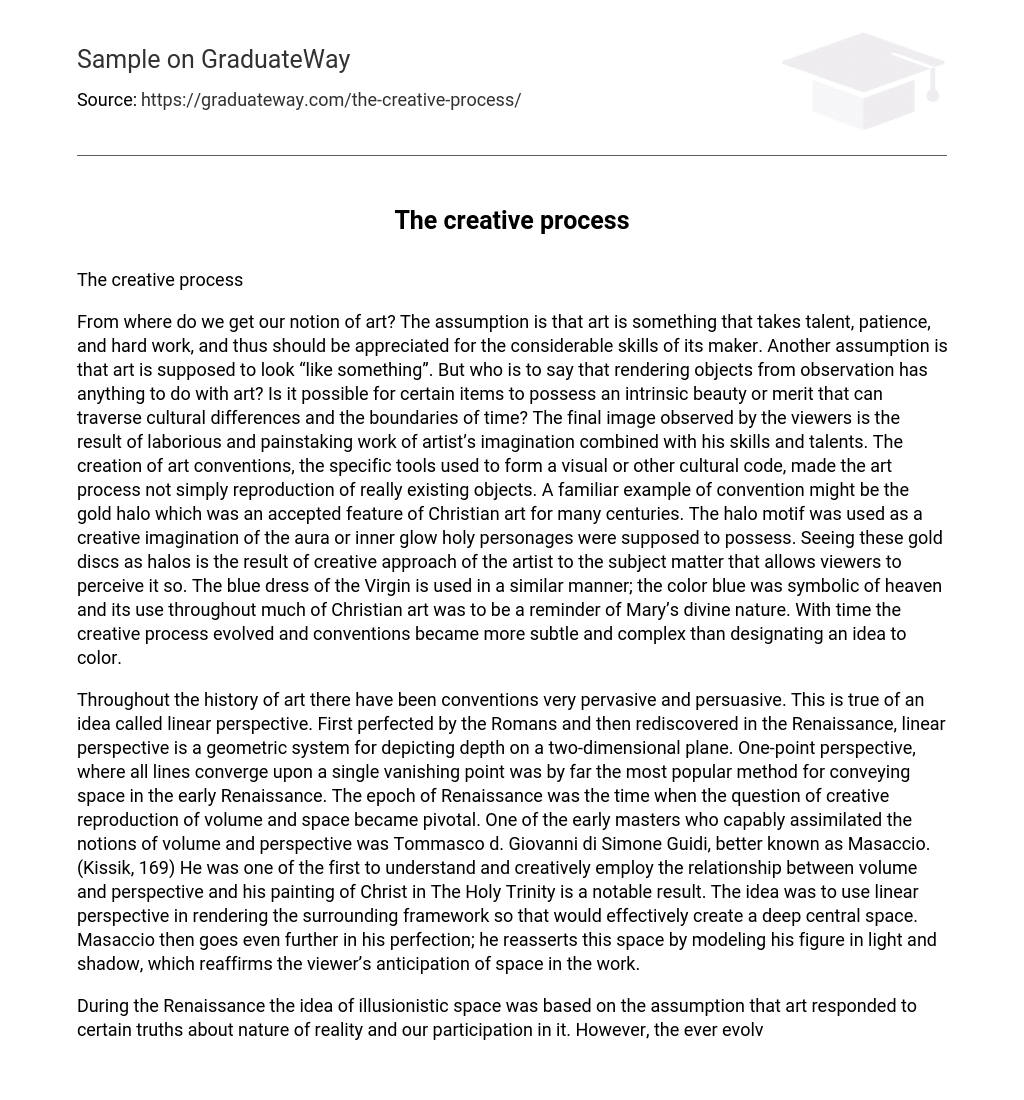From where do we get our notion of art? The assumption is that art is something that takes talent, patience, and hard work, and thus should be appreciated for the considerable skills of its maker. Another assumption is that art is supposed to look “like something”. But who is to say that rendering objects from observation has anything to do with art? Is it possible for certain items to possess an intrinsic beauty or merit that can traverse cultural differences and the boundaries of time? The final image observed by the viewers is the result of laborious and painstaking work of artist’s imagination combined with his skills and talents. The creation of art conventions, the specific tools used to form a visual or other cultural code, made the art process not simply reproduction of really existing objects. A familiar example of convention might be the gold halo which was an accepted feature of Christian art for many centuries. The halo motif was used as a creative imagination of the aura or inner glow holy personages were supposed to possess. Seeing these gold discs as halos is the result of creative approach of the artist to the subject matter that allows viewers to perceive it so. The blue dress of the Virgin is used in a similar manner; the color blue was symbolic of heaven and its use throughout much of Christian art was to be a reminder of Mary’s divine nature. With time the creative process evolved and conventions became more subtle and complex than designating an idea to color.
Throughout the history of art there have been conventions very pervasive and persuasive. This is true of an idea called linear perspective. First perfected by the Romans and then rediscovered in the Renaissance, linear perspective is a geometric system for depicting depth on a two-dimensional plane. One-point perspective, where all lines converge upon a single vanishing point was by far the most popular method for conveying space in the early Renaissance. The epoch of Renaissance was the time when the question of creative reproduction of volume and space became pivotal. One of the early masters who capably assimilated the notions of volume and perspective was Tommasco d. Giovanni di Simone Guidi, better known as Masaccio. (Kissik, 169) He was one of the first to understand and creatively employ the relationship between volume and perspective and his painting of Christ in The Holy Trinity is a notable result. The idea was to use linear perspective in rendering the surrounding framework so that would effectively create a deep central space. Masaccio then goes even further in his perfection; he reasserts this space by modeling his figure in light and shadow, which reaffirms the viewer’s anticipation of space in the work.
During the Renaissance the idea of illusionistic space was based on the assumption that art responded to certain truths about nature of reality and our participation in it. However, the ever evolving process of creating art re-appraised the assumptions about the way the world works and the artist set quite opposite aims. These were the Cubists who by inverting the conventions that once defined the nature of reality reinvented the world of painting through decidedly twentieth-century temperament. The Cubists’ idea of flatness takes its premise from the notion that truth in painting must correspond to the physical reality of the two-dimensional plane and the shifting nature of perception. The creative process acquired a disintegrating character. For example, Picasso’s portraits move away from natural appearance and traditional conventions for the depiction of volume. The viewer sees the bodies on his portraits as fragmented, dislocated yet still identifiable assemblages of forms. Picasso’s collapse in the middle and background into the immediate vicinity of the figure enhances the dispersion of the body across the picture plane.
The way the artists achieve systematic destruction of space on two-dimensional plane is that they through their artistic view experienced destruction of human values. Cubism dismantled the methods of earlier art and its radical disregard for established truths was part of a more general cultural and intellectual overhaul taking place in the first decade of the twentieth century.
Thus, each epoch finds its representation in the numerous artistic works which are not simple rendering of reality into canvas but rather the results of the creative process that underwent social influence.
Reference:
Kissick, John, Art. Context and Criticism. WCB Brown & Benchmark, 1993





